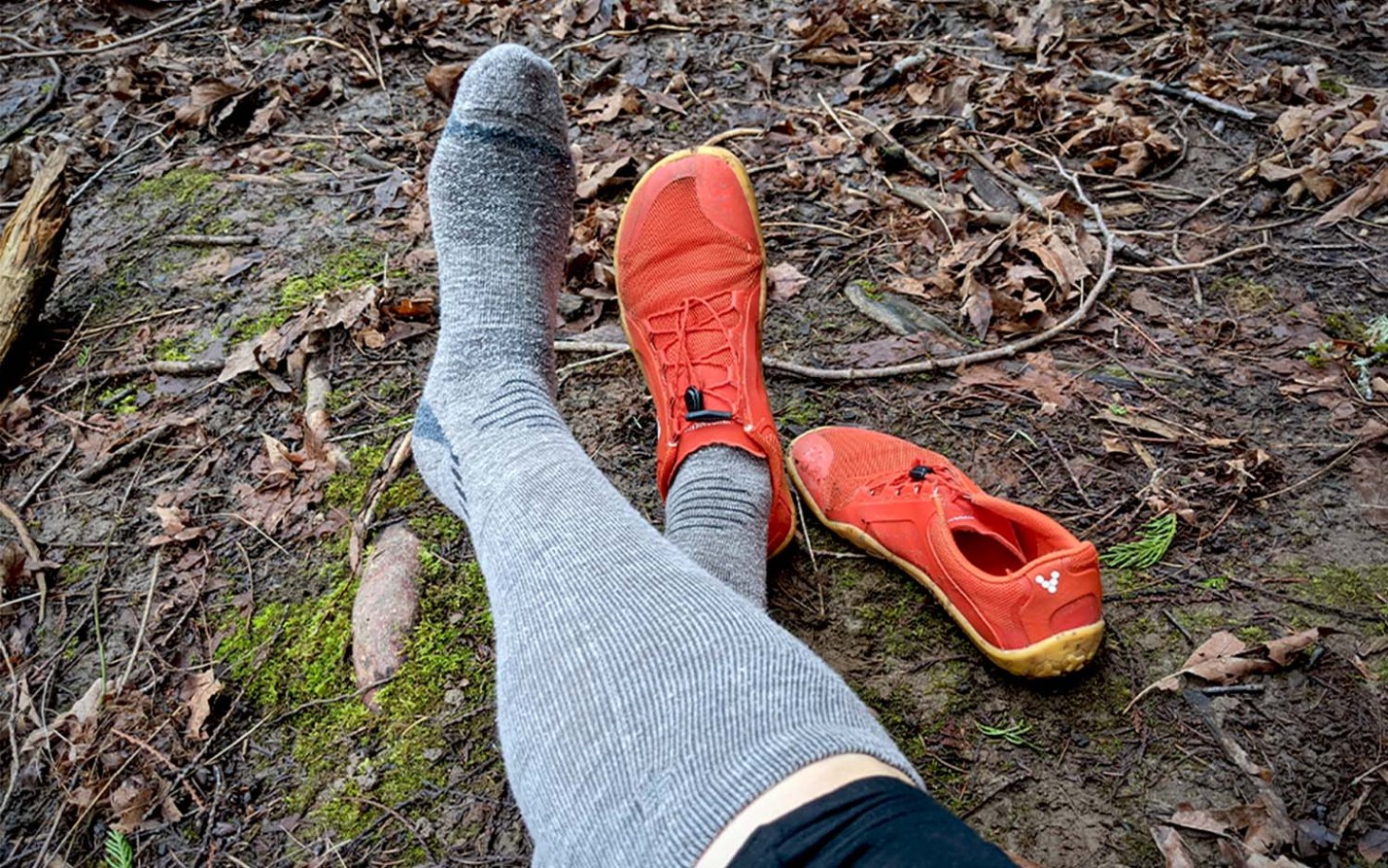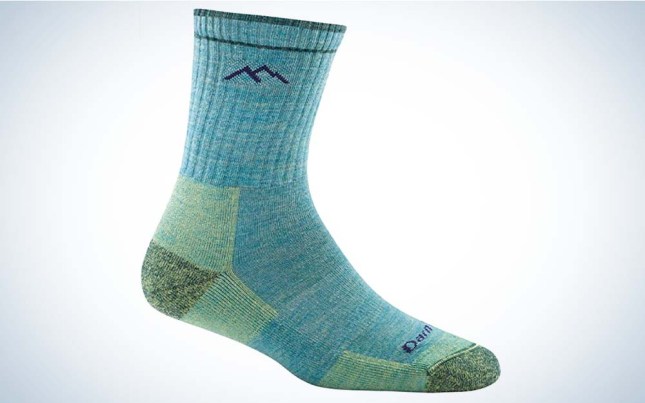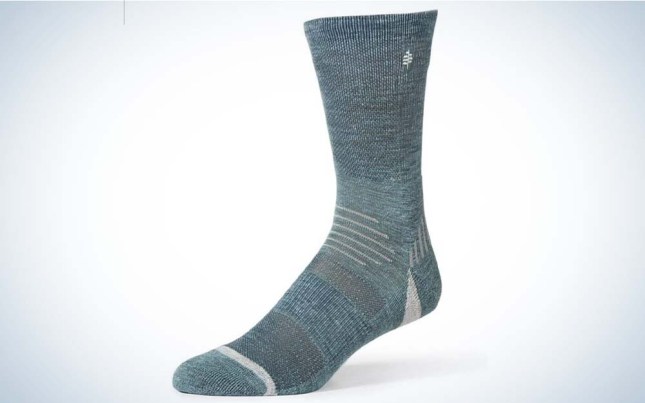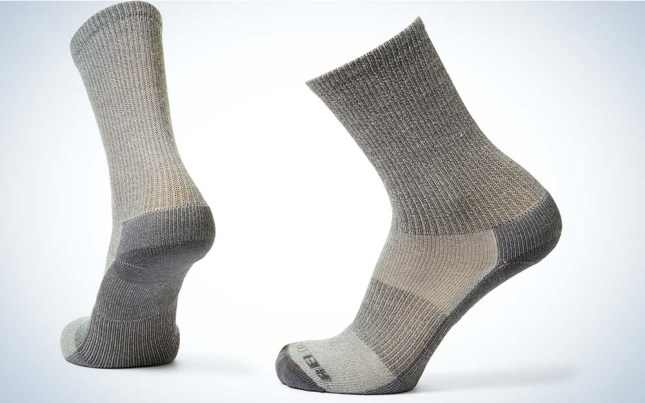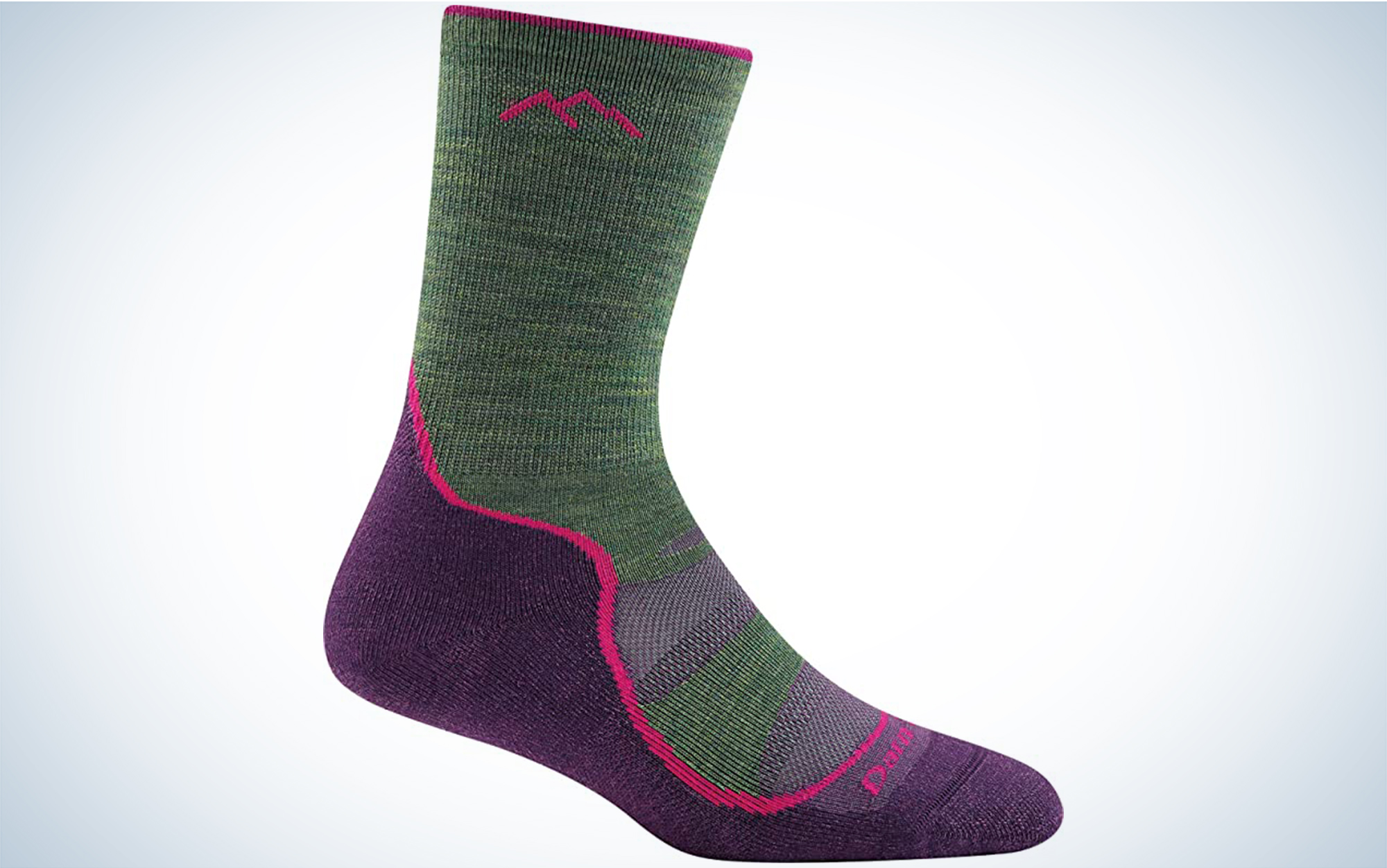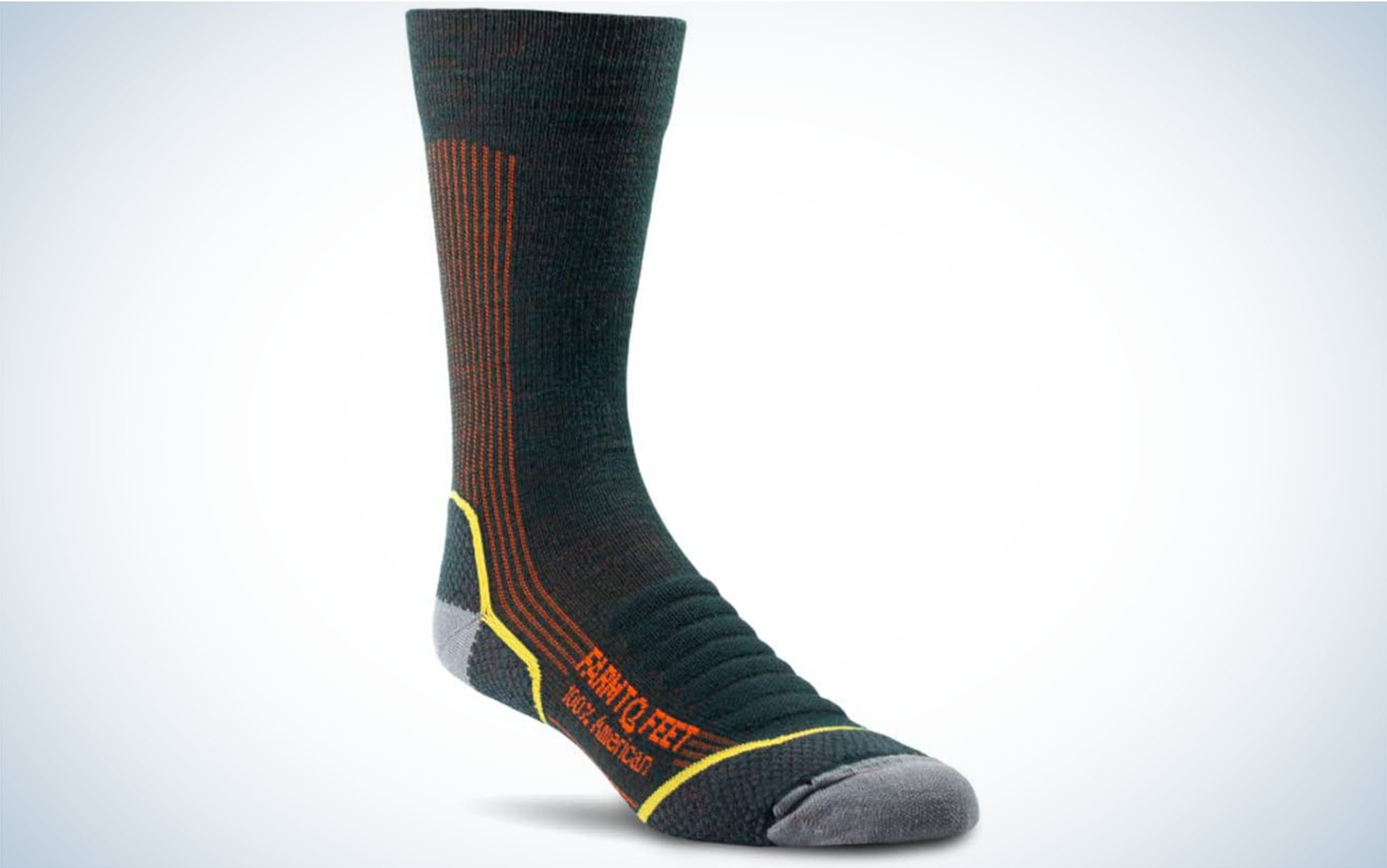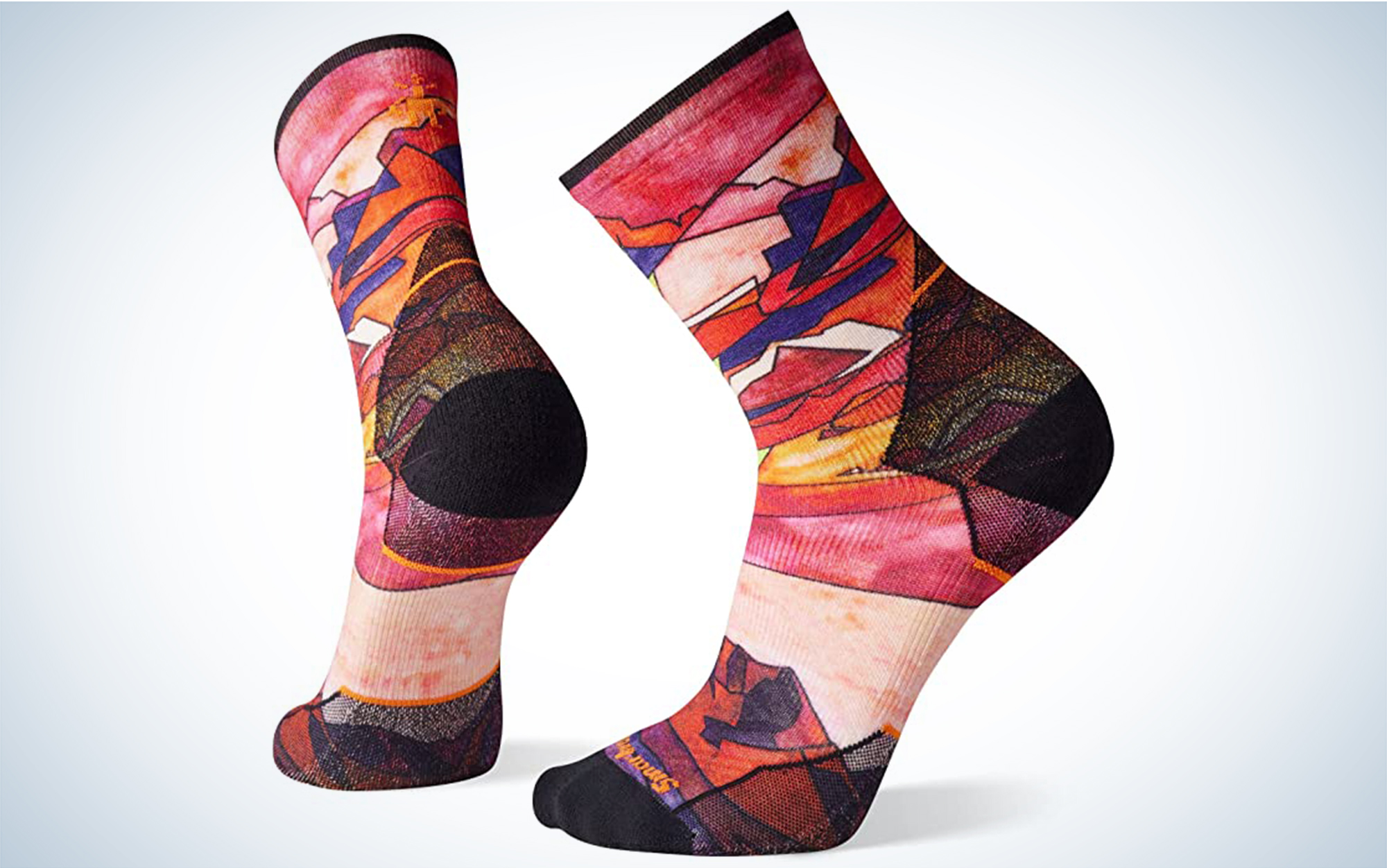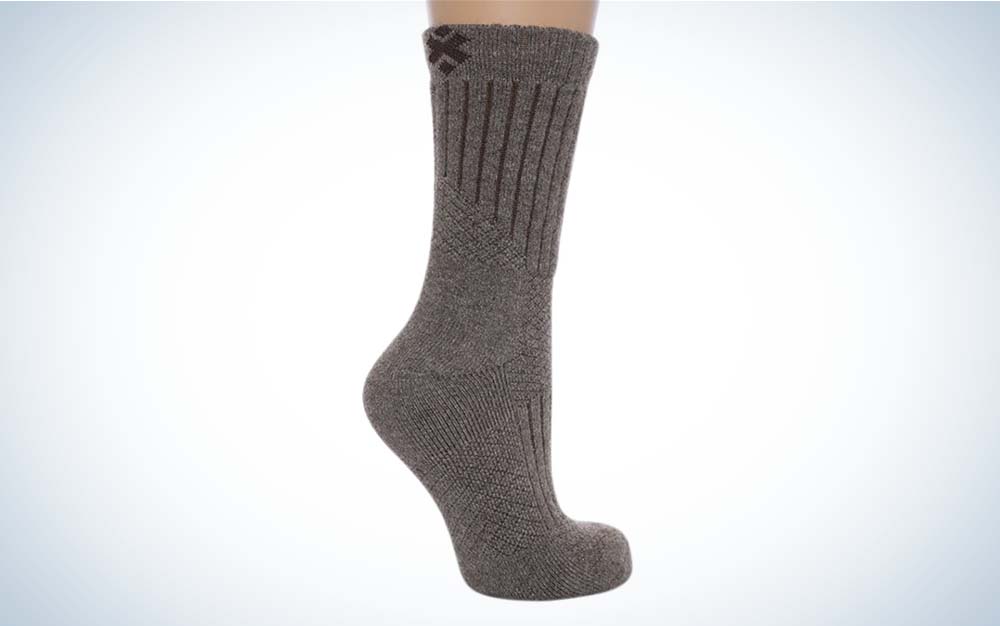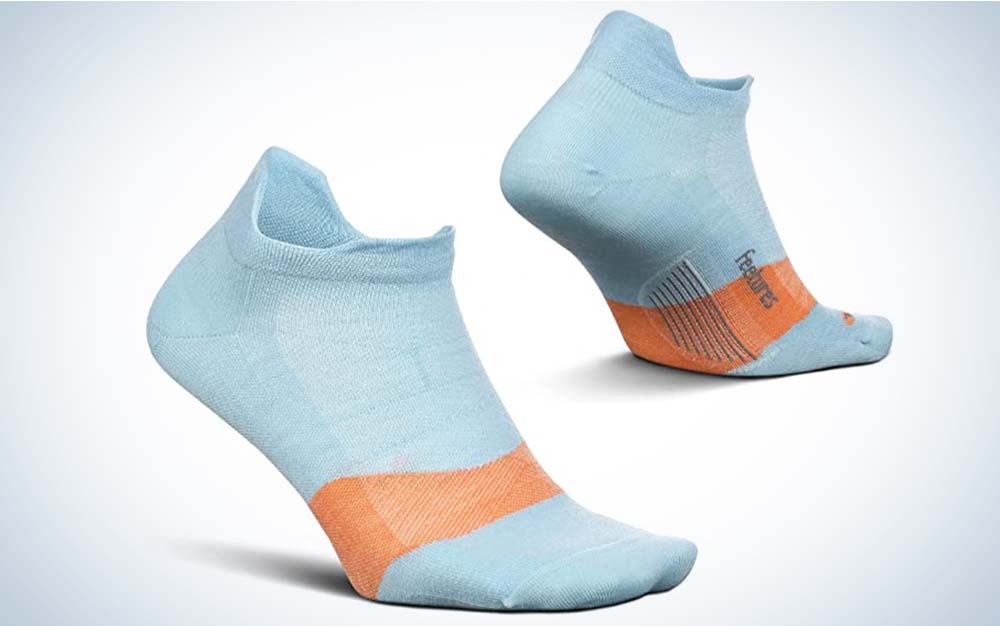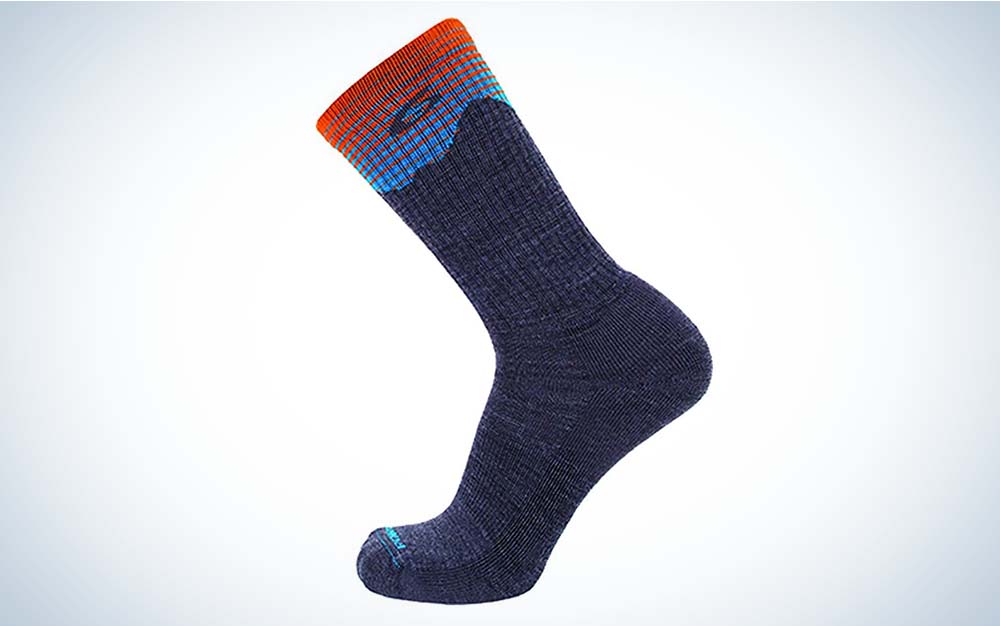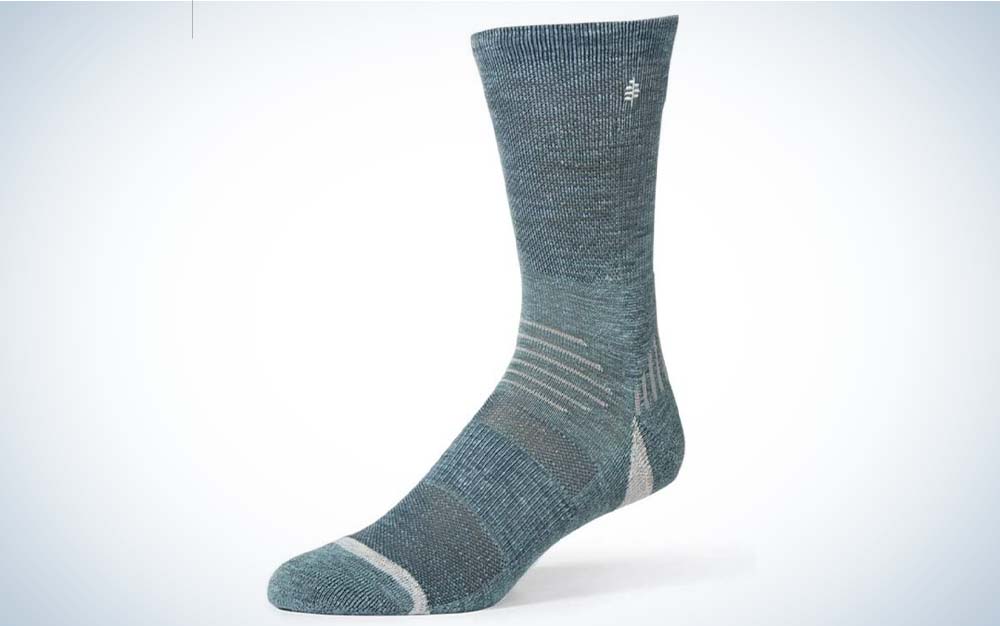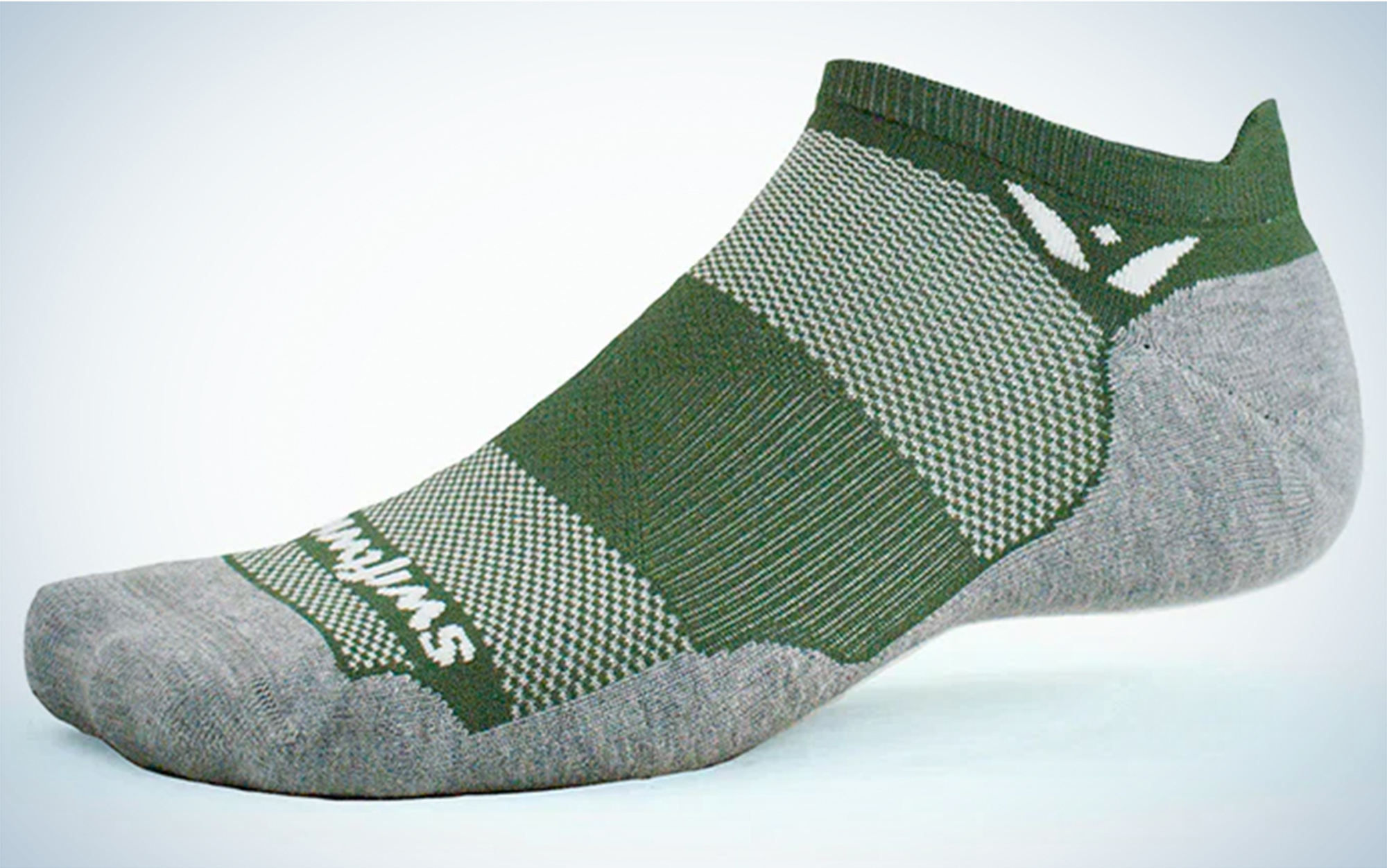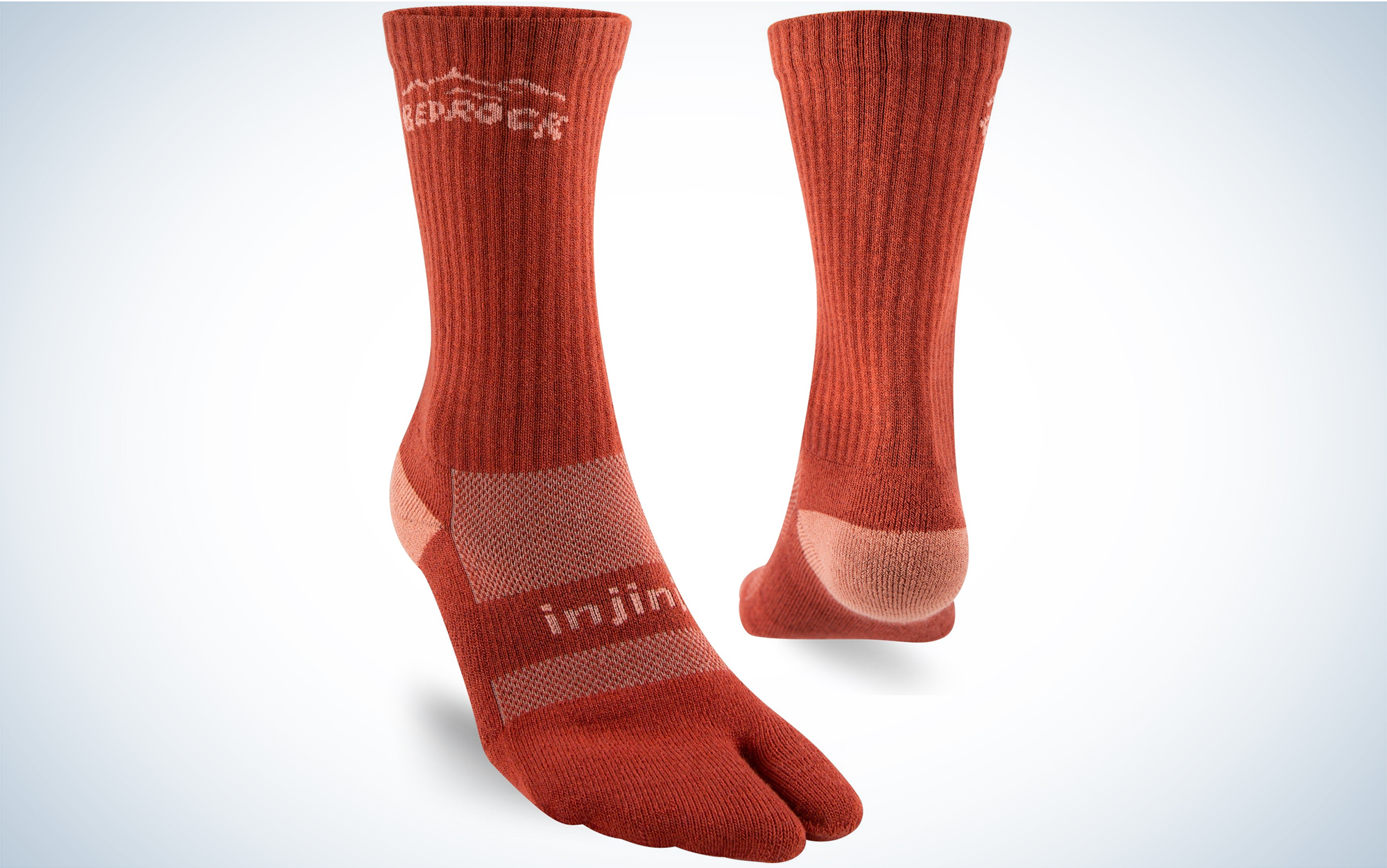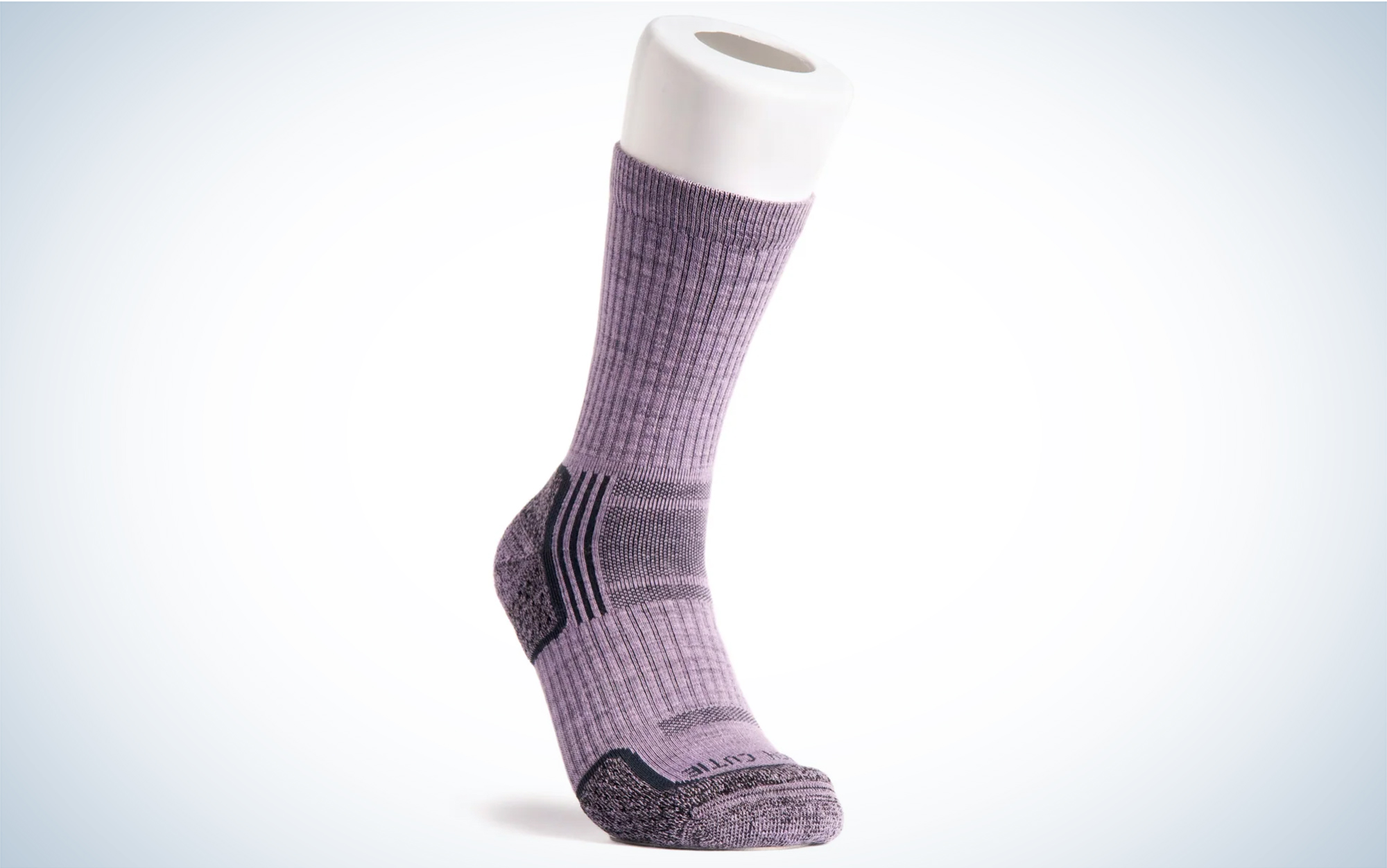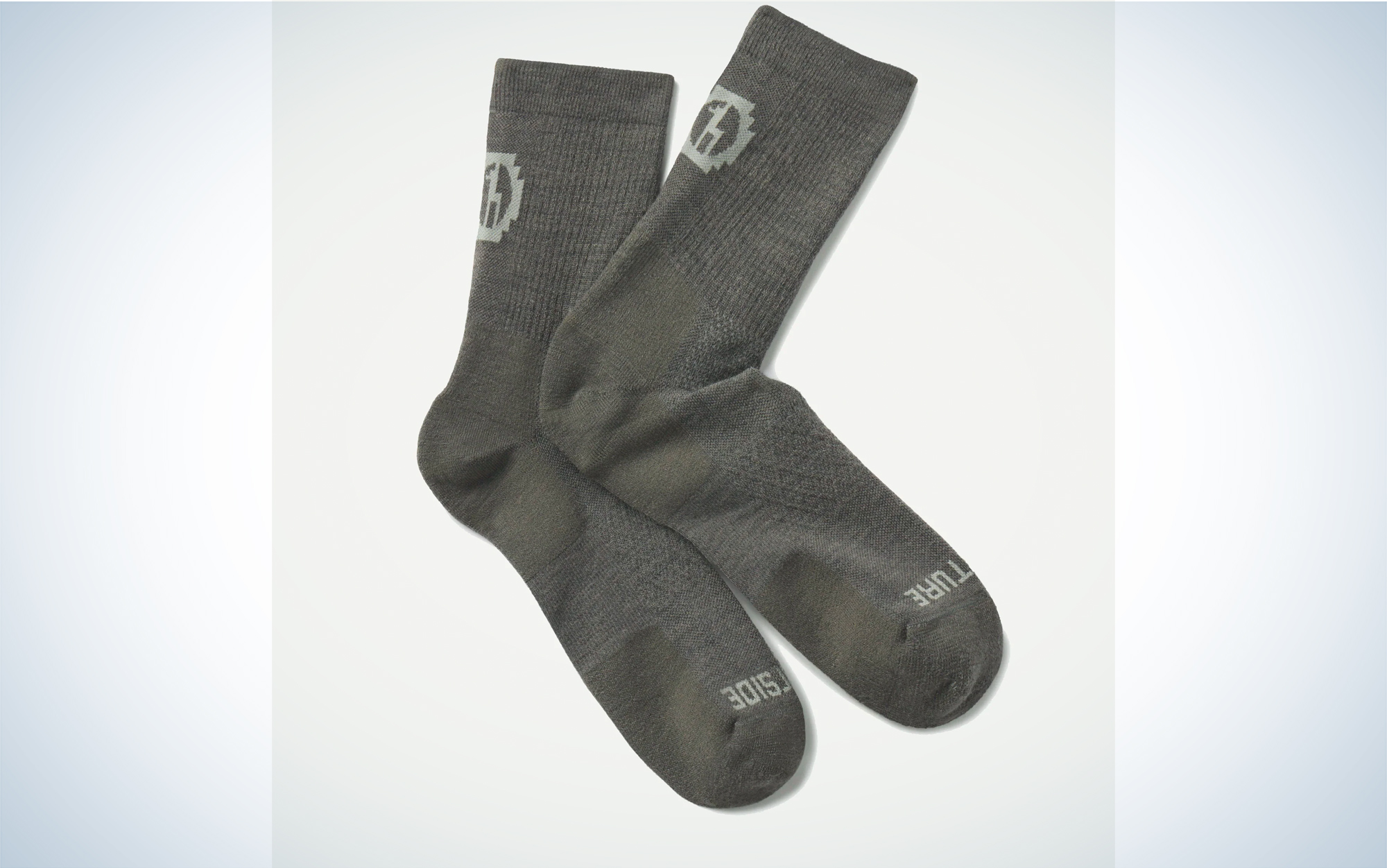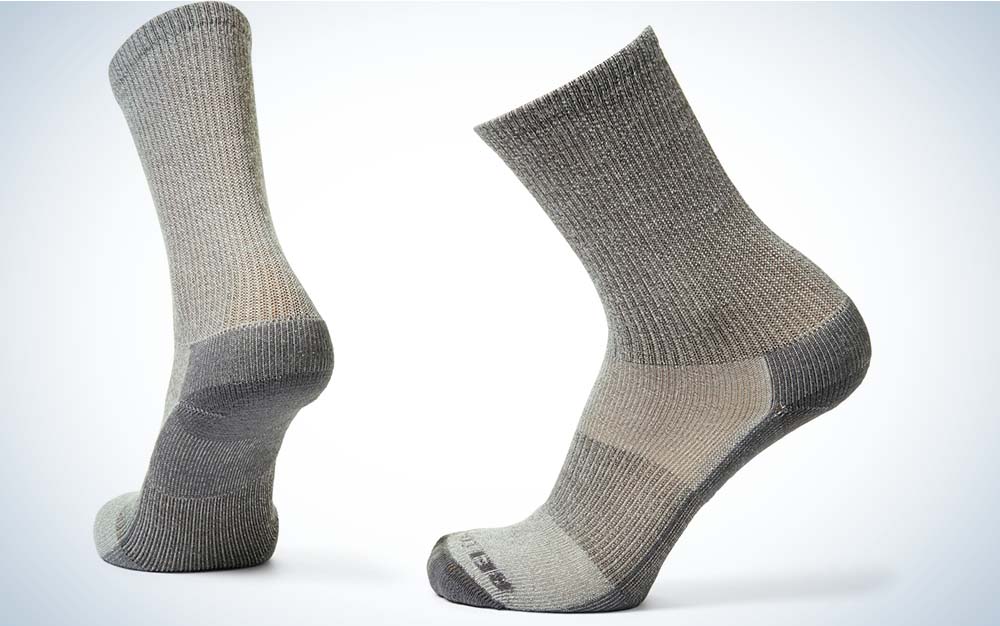We may earn revenue from the products available on this page and participate in affiliate programs. Learn More ›
It only takes one blister on the back of your heel to discover the importance of a good hiking sock. More than almost any other piece of gear in your kit, a quality hiking sock can make the difference between a fun day on the trail with friends and a crippling sufferfest that no amount of moleskin can fix. To help you avoid such a sufferfest, testers and myself tried socks on everything from day hikes to thru-hikes across the country to find the best hiking sock for your next adventure.
- Best Overall: Darn Tough Light Hiker Micro Crew
- Best Made in the USA: Farm to Feet Damascus ¾ Crew Light Targeted Cushion
- Most Comfortable: Happy Yak The Purist
- Best No-Show: Feetures Merino 10 No Show Tab Cushion
- Best for Rugged Conditions: Point6 37.5 Hiking Peak Light Cushion Crew
- Best for Moisture Management: Royal Robbins Venture Crew Sock
- Best Synthetic: Swiftwick Maxus Zero Tab
- Best for Barefoot Shoes: Bedrock Sandals Injinji Performance Split-Toe Socks
- Best Knit: Tough Cutie Merino Wool Hiker Crew
- Best Wool Alternate: Paka Performance 3/4 Crew Socks
- Best Budget: REI Co-op Merino Wool Ultralight Crew Hiking Socks
How I Tested the Best Hiking Socks
I’ve tested dozens of socks from major brands like Balega, Swiftwick, Thorlo, Lorpen, Wigam, Royal Robbins, Farm to Feet, Icebreaker, Injinji, Orvis, Fox River, Wrightsock, and more. To find the best of the best, testers and myself have taken the best hiking socks on everything from dayhikes to trail runs to thru-hikes in a variety of climates and regions, from the damp foothills of the Cascade Range to the arid chill of the Rockies and the blistering heat of the deserts of Southern California. For this review, I considered features such as durability, moisture management, comfort, and fit. These picks had hundreds, some thousands, of miles put onto them over the course of one or more seasons to provide unique insight into the lifespan of each.
OL’s best overall pick, among others, is based on a section hike of the 362-mile Oregon Coast Trail with five testers whose experience levels ranged form 500 miles of lifetime backpacking to 11,000 miles. We took seven pairs of the best wool-blend socks on that trek to determine which was the best wool sock. We additionally considered price and warranty policies in our selections.
Best Hiking Socks of 2024: Reviews & Recommendations
Best Overall: Darn Tough Light Hiker Micro Crew
Key Features
- Available Sizes: Men’s 5.5-17, women’s 4.5-11.5
- Fiber Content: 43 percent merino wool, 54 percent nylon, 3 percent spandex
- Lifetime warranty
- Made in the USA with some imported materials
Pros
- Comfortable
- High performing
- Great warranty
- Fits a wide range of foot sizes
Cons
- None that we’ve found yet
No surprise here, our top pick for the best wool socks, based on a testing trip along the Oregon Coast Trail, is also our best hiking sock pick: the Darn Tough Light Hiker Crew. The tightness of the weave is comfortable in beach grit and forest mud alike. It hugs your foot just enough to stay perfectly in place, but not so much to restrict movement or blood flow. It’s got plenty of ventilation out the top and a nice cushioned underfoot.
And when they eventually give out (no sock is truly built for life for a thru-hiker), Darn Tough will replace them (multiple of us had tested that part out, too). That takes the price tag of these socks from being on the steep side to a total steal. And plenty of day hikers may never need to replace them at all: A single pair can easily go for 800 miles or more.
Most of us on the Oregon Coast Trail had used Darn Tough Light Hikers before, and this trip reconfirmed our commitment to this sock. It’s one of the biggest no-brainer choices when I’m packing for a trip. They are such high-performers that they typically pull double-duty for me as everyday socks, too, and they are even what I wore on my first deer hunt.
If you’re a member of the juicy calf club or tend toward the best hiking shoes for wide feet, I’ve got good news: Darn Tough has launched a sister brand, Wide Open, that has increased the width and flex across the entire sock.
Best Made in the USA: Farm to Feet Damascus ¾ Crew Light Targeted Cushion
Key Features
- Available Sizes: Men’s 6-14.5, women’s 4-12.5
- Fiber Content: 44 percent merino wool, 52 percent nylon, 4 percent spandex
- Lifetime warranty
- Made in the USA with American wool
Pros
- Comfortable
- Uses U.S. wool in addition to U.S. manufacturing
Cons
- Padding on the upper was a touch much for our testers
While nearly all of the best sock brands are based out of the U.S., Farm to Feet takes this to the next level by sourcing the raw materials (merino wool, nylon, and spandex) from U.S. suppliers as well. That supports American workers and businesses, and cuts the overall carbon emissions by shrinking the distance raw materials travel to Farm to Feet’s North and South Carolina manufacturing facilities.
Farm to Feet’s Damascus sock is well padded on both the top and bottom. They are made from a high-performing blend of merino wool and nylon. For our testing crew, the elastic along the upper was a hair tight on our calves (serious backpackers rarely have skinny legs), and the extra bulk from the upper padding took up a noticeable amount of space in our shoes. While this sock doesn’t quite have the versatility of the Darn Tough Light Hiker, it’s an excellent mid to late season option. When the temperatures run even colder than that, check out Farm to Feet’s Kodiak.
Best for Trail Runners: Smartwool Athlete Edition Run Mountain Print Crew Socks
Key Features
- Available Sizes: Men’s 6-14.5, women’s 4-12.5
- Fiber Content: 49 percent merino wool, 45 percent nylon, 4 percent elastane, 2 percent polyester
- Lifetime warranty
- Made in the USA with imported wool
Pros
- Great performance
- Fun designs
- No slip
Cons
- Expensive
Trail runners need socks that can put up with abuse after abuse and still perform. The Smartwool Athlete Edition Run Mountains start with a big chunk of of merino wool (excellent for moisture management and temperature control) and then add in almost as much nylon for durability. To tackle one of the biggest failure points for running socks (the toes), these also have an extra chunk of cushioning—useful if you bang your toes on an errant root during a run. I’ve also found during testing that these socks stay in place better than anything I’ve tried. I never think about them when I’m running, which also means they’re always the pair I reach for before heading out.
Most Comfortable: Happy Yak The Purist
Key Features
- Available Sizes: Men’s 4-14.5; women’s 5-13
- Fiber Content: 80 percent yak cashmere, 20 percent acrylic
- No warranty
- Made in Mongolia with Mongolian wool
Pros
- Next-level comfort
- Retains heat better than similar-weight merino socks
- Wool alternative for those with allergies
Cons
- Less durable than other socks
- Pricey
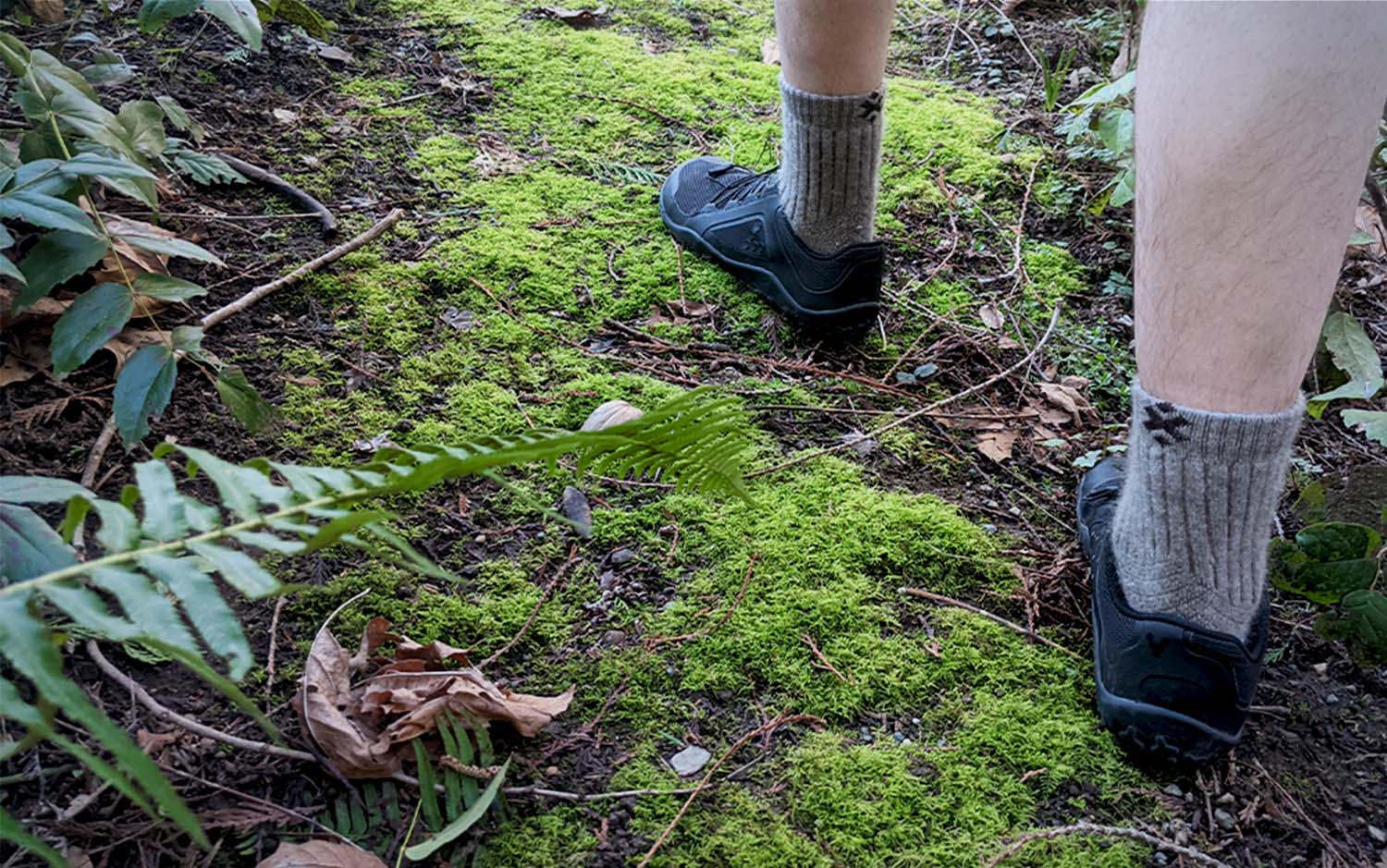
The Purist turned me from a merino die-hard to a yak cashmere evangelist. Whereas wool fibers are naturally scaly, yak cashmere—the fancy term for the hair that is closest to the yak’s body—are smooth. They’re also completely hollow. This traps warm air inside to warm your feet and (merino fibers are semi-hollow) stay warmer for longer.
I tested these socks on a 250-mile section of the Colorado Trail, and they kept my feet warmer than wool socks and wicked moisture equally well. The only ding was that they were showing more signs of wear than my other hiking socks (although not enough to be retired from rotation). For those looking for the performance benefits of yak cashmere with greater durability, Happy Yak makes The Adventurist, which incorporates nylon. Air drying these socks also helps improve their lifespan (which you’re doing for your on-trail hand washes anyway, right?).
The only thing keeping The Purist from taking over my sock drawer is the high price ($60). For that reason, this sock usually stays in my pack until the last day of a trip. That’s when my feet need a little luxury to get through those final miles.
Best No-Show: Feetures Merino 10 No Show Tab Cushion
Key Features
- Available Sizes: Men’s 6-15.5, women’s 4-13
- Fiber Content: 43 percent nylon, 28 percent wool, 27 percent Tencel, 2 percent spandex
- Lifetime warranty
- Made in the USA with imported materials
Pros
- Doesn’t slip
- Great moisture management
- Light compression at the arch helped reduce fatigue
Cons
- Too warm for year-round use
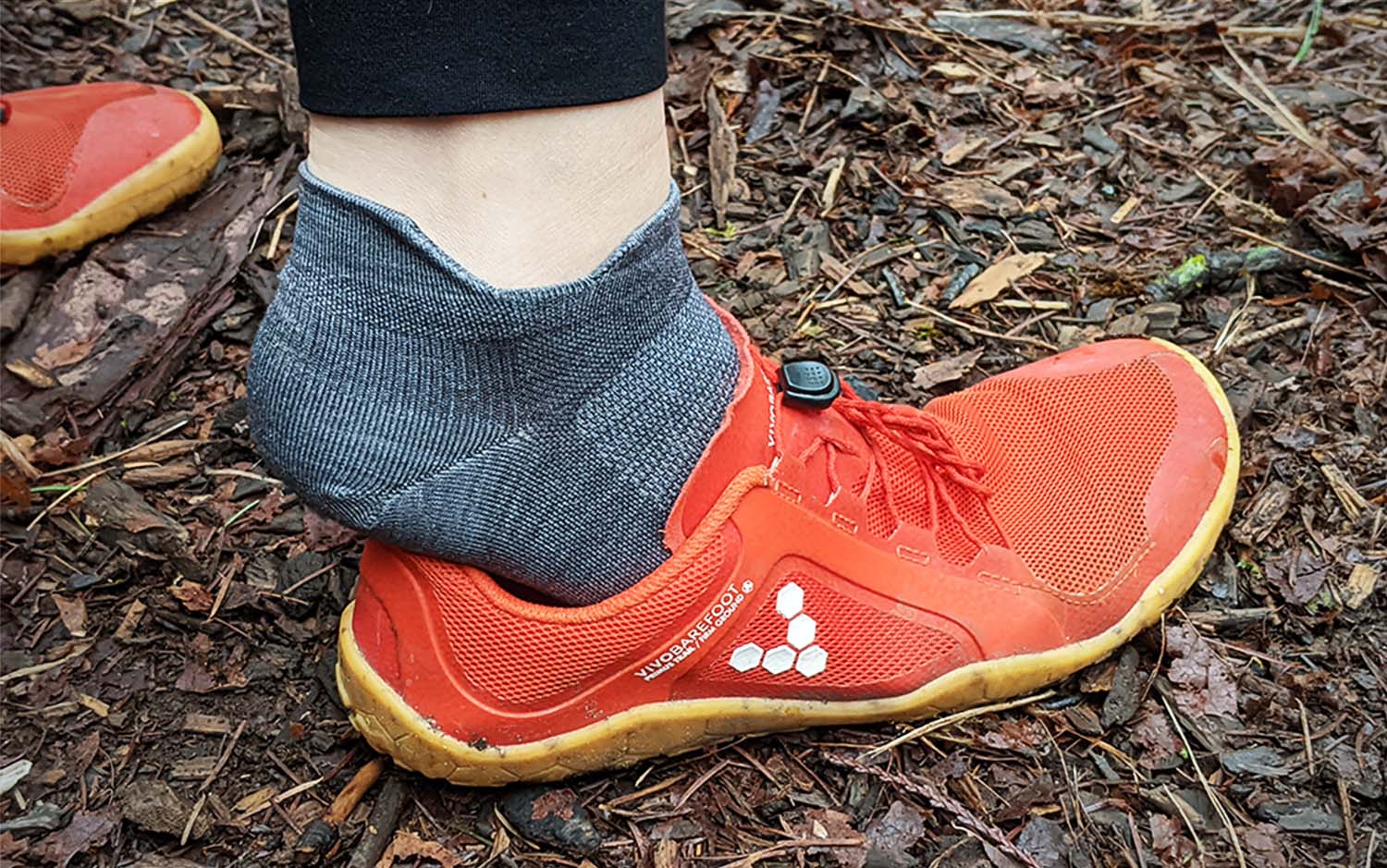
Feetures’ Merino 10 is one of the few no-show socks that actually stays in place on all-day adventures, without slipping under the arch or tugging on the tab. The secret here is extra spandex woven into the arch for a fitted feel that, I was happy to discover, also helped my feet feel fresher over the long haul. The merino and thin weave ensured that moisture wicked out as soon as it built up and kept one tester’s feet dry on a drizzly day in muddy conditions.
This sock has a high nylon percentage, which makes it unusually durable. It only showed slight fraying under the balls of the foot and at the toes (back of the heel looks like new) after a full season of use in the Oregon Cascade Range. The tester said that this sock was just a hair too thick to wear on blistering trail runs during the height of summer, but that their feet appreciated the padding during the rest of the year.
Best for Rugged Conditions: Point6 37.5 Hiking Peak Light Cushion Crew
Key Features
- Available Sizes: Men’s 6-14.5; women’s 4-12.5
- Fiber Content: 54 percent wool, 40 percent nylon, 6 percent elastic
- Lifetime warranty
- Made in the USA with imported materials
Pros
- Endures the most rigorous trails
- Keeps feet dry and blister free in hot conditions
- Hold their shape well on multi-day trips without washing
Cons
- Less comfortable skin-feel than other socks on this list
Keeping your feet dry during the heat of summer is one of the most important things you can do to keep blisters at bay. Usually, that means choosing a thin sock so heat isn’t trapped next to your skin. But these midweight socks buck the trend by incorporating carbon (from volcanic ash, of all things) into the knit. This sped up the natural wicking properties of the already high merino wool content—which made these some of the least smelly socks I’ve tested.
I was also impressed by this sock’s durability. One pair of 37.5s got an unfortunate first hole when a perfectly positioned stick jammed through the undersoles of a tester’s shoes during a trek through Southern California. Rather than ditch them for a new pair, they took a stroll for another 150 miles. That hole never got any bigger, so they kept the socks.
Best for Moisture Management: Royal Robbins Venture Crew Sock
Key Features
- Available Sizes: Men’s 6-14.5; women’s 7-12.5
- Fiber Content: 56 percent polyester, 37 percent hemp, 7 percent elastane
- Limited lifetime warranty
- Made overseas
Pros
- Excellent wicking ability
- Textured feel is surprisingly refreshing
- Hemp is an eco-friendly wool alternative
Cons
- Holds onto more dirt and grime than other socks
- Prone to pilling
Hemp is not a traditional fiber for hiking socks, but the Venture Crew shows that maybe it’s time for that to change. On a humid overnight in Nebraska when the mercury broke 90, these socks kept the sweat away from one tester’s skin better than their merino counterparts. This is because the channels running down the fibers help move sweat away from the body unlike merino.
The texture on this sock is hard to describe. It isn’t soft—at times, it almost felt like it was exfoliating my skin—but it ranked high for comfort compared to traditional wool socks and ended up as a top choice to take on a section of the Pacific Crest Trail. My only complaint is that trail debris tends to hang onto the cuffs on longer treks, making trail laundry more of a chore than I’d like.
Best Synthetic: Swiftwick Maxus Zero Tab
Key Features
- Available Sizes: Men’s 3-15, women’s 4-16.5
- 52 percent polyester, 44 percent nylon, 4 percent spandex
- Lifetime warranty
- Made in the USA from imported materials
Pros
- Great skin feel for a synthetic sock
- Affordably priced
- Stay put fit on hikes and trail runs alike
Cons
- Some pilling after long-term use
- No merino wool content
After thousands of miles of hiking, I’m confident in saying that most people will be happy with socks that incorporate merino wool. The performance of these natural fibers for moisture management, temperature regulation, and odor control are outstanding.
But there are a couple of reasons why you might want to choose a synthetic sock. The first is cost: high-quality merino wool is just more expensive than synthetic materials like nylon and polyester. But a second, surprisingly common reason, is sensitivity to wool. While the merino wool used in the best wool socks is treated to minimize the scratchiness of the fibers, for some people these socks will still result in rashes or other skin irritations.
No matter: there are plenty of great synthetic options available. One of my favorites is the Swiftwick Maxus Zero Tab. After wearing it for hikes, trail runs, and as an everyday sock for months I’ve been impressed by its comfort and no-slip fit—even on the steepest trail runs. It’s even managed to resist picking up unwanted smells (at least for now). My only nitpick is that this sock pills more than the other (merino) socks in my lineup, suggesting some long-term durability issues.
Best for Barefoot Shoes: Bedrock Sandals Injinji Performance Split-Toe Socks
Key Features
- Available Sizes: Men’s 5-15, women’s 6-12
- Fiber Content: 65 percent nylon, 33 percent CoolMax, 2 percent Lycra
- 1 year warranty
Pros
- Foot-shaped sock that works well with barefoot-style shoes in addition to thong sandals
- Will fit wider feet better than more constrictive options
Cons
- Limited colors and heights
From my research into the best barefoot shoes, I learned that there is some disagreement in the barefoot community about socks. The basic idea here is that unfettered toe splay is integral to proper running and walking form in barefoot shoes, and the vast majority of modern socks inhibit this through a constrictive design that pushes the pinky and big toes inward. Some experts I spoke with thought this problem was overblown; others felt getting rid of your traditional sock was nearly as important to achieving correct form and balance as changing to a zero-drop, low-stack height shoe.
Of course, there is one style of sock that is the exception to this: the toe sock. Like Vibram FiveFingers, these manually separate your toes into their own distinct pouches. Some people swear by these socks; others find them distracting. I’m in the latter camp, myself, which is why I was curious to try the Bedrock Sandal Injinji Split-Toe sock. This sock has a separate pouch for your big toe, but is closed across the rest of the toebox. Because the big toe operates independently of the rest of your toes anyway, this is a lot less distracting than typical toe socks. Crucially, this sock also maintains the shape of the forefoot across the closed-up section of the toebox, so there is still ample space for toe splay. Despite their comparable roominess, I’ve been impressed by how well these socks stay put when I’m out on my daily runs. They’re now one of my favorite pairs.
Best Knit: Tough Cutie Merino Wool Hiker Crew
Key Features
- Available Sizes: Women’s 4-13
- Fiber Content: 45 percent merino wool, 51 percent nylon, 4 percent spandex
- No warranty
- Made in the USA with imported materials
Pros
- Extremely comfortable
- WRAP-certified factory
- Women-owned business
Cons
- No warranty
It’s tough to convince our testers that there might be a sock that they like more than Darn Tough, but the Tough Cutie Merino Wool Hiker came close. The Tough Cutie Hiker has a great fit, wrapping around the arch with just a touch of spandex to stay in place. It’s cushioned across the heel and the entire ball of the foot. There is great venting and flex across the top of the ankle, maximizing range of motion.
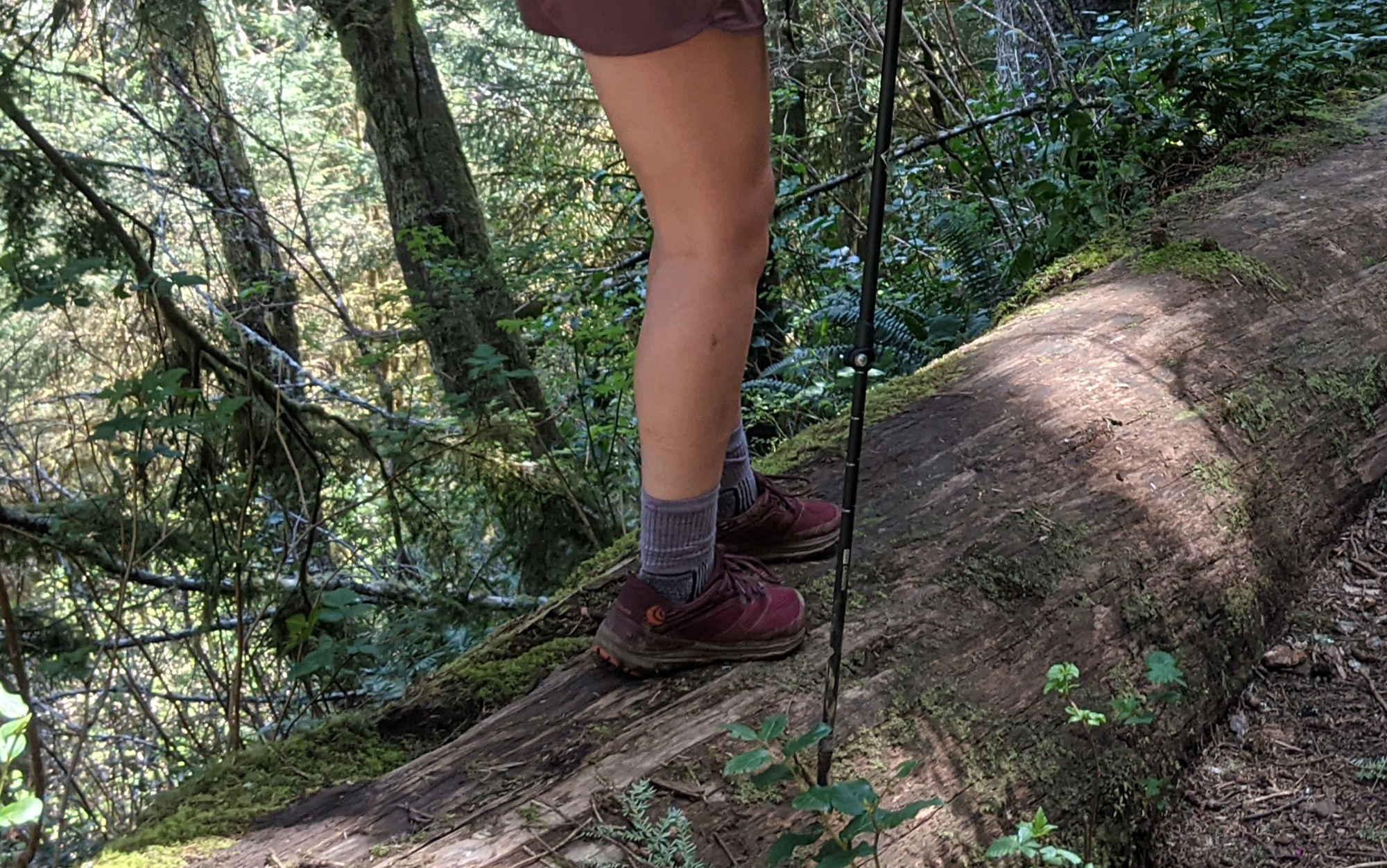
The only problem is that it doesn’t come with a warranty guarantee like some of the other sock manufacturers do. If you typically only purchase new hiking socks every decade or so, that isn’t an issue. However, if you regularly blow through your hiking socks in a single season then the cost for multiple pairs can start to go up.
Best Wool Alternate: Paka Performance 3/4 Crew Socks
Key Features
- Available Sizes: Men’s 6-13; women’s 7-15.5
- Fiber Content: 57 percent nylon, 33 percent alpaca, 7 percent Tencel, 3 percent spandex
- No warranty information
Pros
- Soft to the touch
- Comfortable when worn for multiple days
Cons
- Limited size options
- Doesn’t stay in place as well as other socks I’ve tested
Darn Tough’s hiking socks are great, and my go-to recommendation for just about everyone. The only exception to that is individuals who are allergic to wool, as the naturally occurring lanolin in wool can cause excessive itching. But the alternatives to wool weren’t always there, as too often the only other choices were synthetic (stinky) or wool alternatives like yak wool that were simply too pricey.
The Paka Performance 3/4 sock is an affordable option that bucks the trend. While the majority of the sock is nylon (necessary for durability), a full third of it is made up of alpaca wool, which has many of the same hollow-fiber thermoregulating, moisture wicking, and even odor protection qualities as its wool counterparts. During testing, both Assistant Editor Ashley Thess and I were impressed with how soft to the touch these socks were, and how they excelled at keeping smells at bay, even after multiple days of use.
Best Budget: REI Co-op Merino Wool Ultralight Crew Hiking Socks
Key Features
- Available Sizes: Men’s 5.5-14; women’s 4-12.5
- Fiber Content: 72 percent wool, 26 percent nylon, 2 percent elastane
- One year warranty
- Made in the USA with imported materials
Pros
- Low price given the high merino content
- No smell, even on longer trips
Cons
- Started to lose their shape after consecutive days of use
- Not as soft as other socks in the test
It’s tough to find a pair of high-quality merino socks for under $20, but I found during testing that the REI-branded merino wool socks ($16 at the time of testing) were just as good as many higher priced options. The bulk of the performance benefits comes from the high-wool content, which increases the sock’s ability to wick, retain heat on cold days, and avoid unwanted odors. And vents at the top of the sock and cushioning on the underfoot kept my feet happy and blister-free on longer slogs.
This sock is billed as ultralight, but its thickness is closer to that of a lightweight sock. The price point also comes with some tradeoffs, as these socks tend to bag out after heavy use and are noticeably less soft than the higher-priced pics on this list. Still, I wouldn’t hesitate to throw them on my feet or in my pack for dayhikes or overnight trips.
Things to Consider Before Buying the Best Hiking Socks
While it’s tempting to grab any old pair of socks out of your drawer before hitting the trail, most socks designed for frontcountry life aren’t suitable for outdoor adventures. But sifting through all the different sock styles, from no-show to knee-high, and materials—merino wool, nylon, acrylic, spandex, Tencel, rayon, and more—can make the process of finding the best hiking sock daunting. Here are a few factors to consider before choosing a pair for your next hike.
Comfort
What makes for comfortable feet out on a hike can vary considerably. I considered a number of factors in the below picks, from moisture management (for hikers with sweaty feet), to merino alternatives (for hikers with wool allergies), to the quality of construction.
Conditions
There are very few climates where you’ll be able to get by with only one type of hiking sock for every season—for most, you’ll want to consider the types of conditions you’ll encounter before making a purchase. In the Pacific Northwest, for example, the mud and fog of the fall call for a sock that can keep the grit and grime out, while excellent moisture wicking is necessary during the hot and dry months of late summer.
Longevity
All hiking socks give out eventually, but some last considerably longer than others. The most durable socks are typically less soft and more expensive, so consider how important each of these factors are to you when making your selection.
Price Point
While an individual pair of hiking socks is (usually) affordable, small differences in price can add up when you need multiple pairs. That being said, I recommend aiming for a sock in the $20-$25 range for everyday hiking. The lifespan of these higher quality hiking socks usually justifies the higher price tag.
Read Next: The Best Hiking Underwear for Women of 2024
FAQs
Hiking socks can cost anywhere from $10 to $60, but the best hiking socks are typically around $20 to $25. Less than that and you are likely to run into durability issues, and you may notice more blisters than you would have otherwise seen. Higher priced socks typically come with extra cushioning, a specialized fiber (like my yak cashmere pick), fine-gauge merino wool, or some other unique performance benefit.
The best type of sock for hiking is one that wicks away moisture from your feet, as wet feet are prone to developing blisters—this is why the best hiking socks are almost never made out of cotton, which retains moisture. The go-to fiber for moisture wicking is merino wool, which has the added benefit of being naturally antimicrobial (so your feet are less likely to smell), but synthetic fibers can work just as well.
The best hiking socks for summer are the ones that will keep your feet dry. They can accomplish this by being unusually thin, so that moisture can escape easily, incorporating fibers that wick away moisture well, such as merino, or a combination of both. Something to consider is that in places where the ground heats up significantly during summer, such as the desert, thicker hiking socks can help prevent heat blisters from developing on the underside of your feet.
The best hiking socks for sweaty feet are the ones that wick away moisture quickly. Look for socks with a high percentage of merino (or a synthetic that is designed for wicking), and consider what kind of shoes you are planning to pair them with. If you are wearing trail runners, where moisture can easily escape, thinner socks may work better to keep your feet dry. In traditional hiking boots, which can become swampy in hot conditions, thicker hiking socks can help provide a buffer between your feet and the sweat wicking to the outside of the sock.
To find the hiking socks that will be the most comfortable, first consider your conditions. For cold-weather hiking, it’s best to choose heavyweight socks, while a midweight or lightweight sock would be more appropriate for the summer. If conditions are muddy or buggy, a crew height can help protect your legs. And if there are any stream crossings on your upcoming hike, the most comfortable socks will be the extra pair tucked into your pack.
Thin socks can be good for hiking in the right conditions. If you are wearing lightweight, cushioned shoes (such as trail runners) on a hot day, thin socks will wick away moisture faster than thicker socks. But if you are wearing hiking boots or low-cut hiking shoes, which tend to be made out of stiffer materials, you may find that the cushion provided by thicker hiking socks keeps your feet comfortable for longer and results in fewer blisters.
Socks that are made from 100 percent wool will tend to be less durable than those that are blended with more durable nylon fibers.
Modern wool socks are meant to be worn directly against the skin and should not be itchy. The exception to that is individuals with wool allergies, who will likely still experience wool socks as itchy.
Final Thoughts on the Best Hiking Socks
The above best hiking socks are all great choices for dayhiking and overnighters. Some, like the Darn Tough and Point6 socks, I even pack for multi-night trips and thru-hikes. You’ll typically want multiple pairs of hiking socks, so I recommend buying several different kinds to see what works best with your feet, your shoes, and the types of hikes you typically go on.
- Best Overall: Darn Tough Light Hiker Micro Crew
- Best Made in the USA: Farm to Feet Damascus ¾ Crew Light Targeted Cushion
- Most Comfortable: Happy Yak The Purist
- Best No-Show: Feetures Merino 10 No Show Tab Cushion
- Best for Rugged Conditions: Point6 37.5 Hiking Peak Light Cushion Crew
- Best for Moisture Management: Royal Robbins Venture Crew Sock
- Best Synthetic: Swiftwick Maxus Zero Tab
- Best for Barefoot Shoes: Bedrock Sandals Injinji Performance Split-Toe Socks
- Best Knit: Tough Cutie Merino Wool Hiker Crew
- Best Wool Alternate: Paka Performance 3/4 Crew Socks
- Best Budget: REI Co-op Merino Wool Ultralight Crew Hiking Socks
